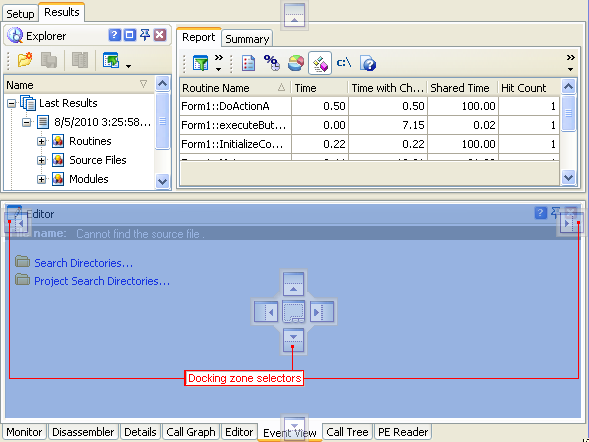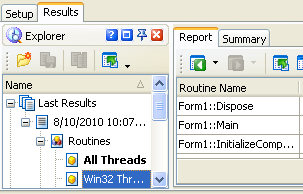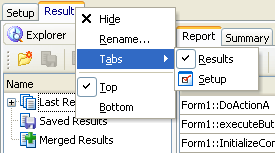You can customize panel layouts in the AQTime and create custom docking schemes. This feature is especially convenient for smaller display resolutions, since it allows you to display several panels simultaneously.
The way you dock and undock panels depends on your AQTime version: standalone or integrated into Microsoft Visual Studio or Embarcadero RAD Studio. If you use the integrated version, AQTime’s panels are fully integrated into Visual Studio or RAD Studio. So you can dock and undock AQTime panels in the same manner as you dock and undock other Visual Studio or RAD Studio panels. Docking panels in the standalone AQTime version is very similar to docking in Visual Studio. The rest of this topic explains how to dock and undock panels in the standalone version of AQTime.
To undock a panel, simply double-click or drag the panel’s caption. This will turn the panel into a normal, floating window. You can quickly dock a floating panel back to its previous location by double-clicking the panel caption. If you want to change the panel location, drag it to the desired place. When you are dragging the undocked panel over another panel, AQTime will show the docking zone selector, which lets you specify where the panel will be docked if you released it:

To dock a panel to the top, left, bottom or right edge of the lower panel, move the mouse cursor to the  ,
,  ,
,  or
or  icon within the Selector and then release the mouse button. Once a floating panel has been docked onto another panel, it still has a caption bar, with a name at the left and buttons at the right, and the previous contents likewise have a caption bar on top of their section of the page. Any section can again be turned into a floating window by dragging the caption.
icon within the Selector and then release the mouse button. Once a floating panel has been docked onto another panel, it still has a caption bar, with a name at the left and buttons at the right, and the previous contents likewise have a caption bar on top of their section of the page. Any section can again be turned into a floating window by dragging the caption.
If you select the  icon in the docking zone selector, the floating panel and the lower panel will be docked at the same spot. In this case, the panels will be organized as tabbed pages (tabbed panels are simply panels docked not inside one another, but at the same spot). You can dock more than two panels to the same spot. To undock a tabbed panel, just drag or double-click its caption. (As we have said, the docking does not depend on the current docking style. If the Native style is selected, the panels can also be docked as tabbed pages and a panel is also undocked, when you double-click its caption).
icon in the docking zone selector, the floating panel and the lower panel will be docked at the same spot. In this case, the panels will be organized as tabbed pages (tabbed panels are simply panels docked not inside one another, but at the same spot). You can dock more than two panels to the same spot. To undock a tabbed panel, just drag or double-click its caption. (As we have said, the docking does not depend on the current docking style. If the Native style is selected, the panels can also be docked as tabbed pages and a panel is also undocked, when you double-click its caption).
Note that when you are dragging a float panel over a tabbed one, besides the docking zone selector in the center of the tabbed panel AQTime will also show docking zone selectors along the edges of the tabbed page. These selectors let you dock the floating panel relative to the whole tabbed spot. Using the central selector you will dock the floating panel to the tabbed panel that is currently in front of the other tabbed pages. If you select this variant, then the tabbed page will hold two panels. The following figure illustrates this situation:

Right-clicking a tab shows the context menu with the following items:

| Menu Item | Description |
|---|---|
| Hide | Hides the tabbed page. |
| Rename | Calls the Panel Caption dialog where you can rename the tab. |
| Tabs | Shows the available panels (currently tabbed). |
| Top and Bottom | Specifies the tab location. |
| Help | The Help item is displayed if the tabbed page contains one panel only. It calls help topic with the panel description. If the tabbed page holds several panels (for example, the Results page in the standalone AQTime version), the Help item is hidden. |
Use the View > Desktop > Docking Allowed menu item to enable/disable docking. When docking is disabled, the current docking scheme cannot be changed. That is, it is impossible to move a docked panel to another location. To customize panel layouts, first check the Docking Allowed menu item and then manipulate the individual panel layouts. To customize details of the display, use the User Interface dialog.
If you feel the panels are undocking a bit too easily, simply lock them in by turning off the View > Desktop > Docking Allowed menu item.
To restore the default panel layout, press the View > Desktop > Restore Default Docking menu item. View > Desktop > Save Docking to File will save the current layout to a .qtdock file, and View > Desktop > Load Docking from File will load a saved layout. The View > Desktop > Save Desktop As and View > Desktop > Load Desktop menu items will save and load the panel layout along with the toolbar layout.
